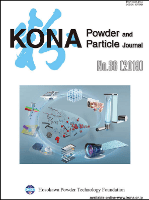
KONA Powder and Particle Journal
Scope & Guideline
Empowering researchers with open access to particle advancements.
Introduction
Aims and Scopes
- Particle Characterization and Measurement:
The journal emphasizes the development and application of methods for characterizing particle size, shape, and distribution, which are crucial for understanding material behavior in various processes. - Powder Processing and Engineering:
Research on the processing of powders, including formulation, granulation, and compaction, is a core component. This includes studies on the effects of processing conditions on powder properties. - Nanoparticle Synthesis and Applications:
The journal covers advancements in the synthesis of nanoparticles and their applications across fields such as catalysis, drug delivery, and energy storage, highlighting innovative approaches in nanotechnology. - Flow and Rheology of Particulate Systems:
Understanding the flow behavior of powders and slurries, including rheological characterization, is a significant focus, essential for optimizing industrial processes involving particulate materials. - Environmental and Health Applications:
The journal addresses the application of particle technology in environmental remediation and health, including studies on air quality, drug delivery systems, and biocompatibility of materials.
Trending and Emerging
- 3D Imaging and Shape Analysis of Particles:
Recent publications show a trend towards utilizing advanced imaging techniques for 3D shape estimation of particles, which is crucial for understanding their behavior in various processes. - Integration of AI and Machine Learning in Particle Technology:
There is a rising interest in applying artificial intelligence and machine learning techniques to enhance particle characterization, optimization, and process control, demonstrating the intersection of traditional science with modern computational methods. - Sustainable and Green Synthesis of Nanoparticles:
Research focusing on environmentally friendly methods for synthesizing nanoparticles is gaining traction, aligning with global sustainability goals and the need for greener technologies. - Biomedical Applications of Particulate Systems:
An increase in studies related to the use of particles in biomedical applications, such as drug delivery and diagnostics, reflects a growing convergence of particle technology with health sciences. - Advanced Material Development for Energy Applications:
Emerging themes in the development of advanced materials, particularly for energy storage and conversion (e.g., batteries and photocatalysts), show significant growth, highlighting the role of particle technology in addressing energy challenges.
Declining or Waning
- Traditional Powder Metallurgy Techniques:
Research focused specifically on conventional powder metallurgy processes appears to be waning, likely overshadowed by advancements in additive manufacturing and new synthesis methods. - Basic Theoretical Modeling of Particulate Systems:
While modeling remains important, there has been a shift away from purely theoretical studies towards more applied research that integrates experimental validation and real-world applications. - Single-Particle Studies:
There seems to be a reduced emphasis on studies that focus solely on single-particle behavior, as the field increasingly recognizes the importance of collective behaviors and interactions in particulate systems.
Similar Journals
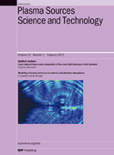
PLASMA SOURCES SCIENCE & TECHNOLOGY
Unveiling the Power of Plasma: Where Science Meets Technology.PLASMA SOURCES SCIENCE & TECHNOLOGY is a premier academic journal published by IOP Publishing Ltd, focusing on the innovative field of plasma science and its applications in technology. Established in 1992, the journal has significantly contributed to advancing knowledge in this crucial area, maintaining a robust Q1 quartile ranking in Condensed Matter Physics as of 2023, which reflects its high-impact research dissemination. With an impressive Scopus ranking of 74 out of 434 in the field of Physics and Astronomy—specifically within Condensed Matter Physics—this journal stands out as a leading source for researchers and professionals dedicated to the study and application of plasma technologies. While it is not an Open Access journal, the published works are accessible through institutional subscriptions, making them available to a wide academic audience. The journal aims to provide a platform for significant contributions related to plasma physics, fostering scientific dialogue and collaboration across various disciplines. As it continues through its converged years up to 2024, PLASMA SOURCES SCIENCE & TECHNOLOGY remains essential for anyone involved in the burgeoning exploration of plasma-related scientific advancements.

INTERNATIONAL JOURNAL OF POWDER METALLURGY
Navigating the Future of Engineering with Powder MetallurgyInternational Journal of Powder Metallurgy, published by the American Powder Metallurgy Institute, is a prestigious periodical dedicated to advancing the field of powder metallurgy and its applications in various engineering disciplines. With its ISSN 0888-7462, this journal has roots tracing back to 1969, showcasing a wealth of research and innovations up to 2022. Although it currently ranks in the fourth quartile in both Industrial and Manufacturing Engineering and Metals and Alloys categories, it serves as a vital platform for sharing new findings, technical advancements, and discussions in powder metallurgy. Despite not being an open access journal, it remains an important resource for researchers, professionals, and students striving to deepen their understanding and expertise within this niche field. The journal’s content not only reflects the ongoing trends in materials science but also encourages interdisciplinary collaboration, making it an essential read for anyone involved in the study and application of powder metallurgy.
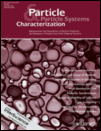
PARTICLE & PARTICLE SYSTEMS CHARACTERIZATION
Unraveling the Mysteries of Particulate SystemsPARTICLE & PARTICLE SYSTEMS CHARACTERIZATION is a distinguished journal dedicated to advancing the knowledge within the fields of Chemistry, Condensed Matter Physics, and Materials Science. Published by WILEY-V C H VERLAG GMBH in Germany, this journal has established a solid reputation since its inception in 1984, showcasing research aimed at understanding the intricate properties and behaviors of particulate systems. With an impressive Q2 ranking in its respective categories and Scopus ranks indicating a robust standing in the global research community, it serves as an essential resource for researchers, professionals, and students. Although it does not currently offer Open Access options, its comprehensive articles and reviews provide valuable insights that contribute significantly to the ongoing discourse in these scientific domains. As it prepares to celebrate four decades of publication, PARTICLE & PARTICLE SYSTEMS CHARACTERIZATION continues to provide a vital platform for emerging knowledge, fostering innovation and collaboration among scientists dedicated to the study of particle systems.
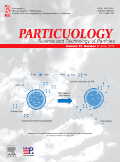
Particuology
Driving Excellence in Chemical Engineering and Materials ResearchParticuology is a premier international journal published by Elsevier Science Inc, focusing on the critical advancements in the fields of *Chemical Engineering*, *Condensed Matter Physics*, and *Materials Science*. As a Q2 journal in its respective categories for 2023, it offers a platform for researchers to disseminate their findings and engage with the latest developments in particle technology and related areas. With an impressive Scopus rank of 71/273 in General Chemical Engineering and 122/463 in General Materials Science, Particuology is positioned at the forefront of scientific inquiry and innovation. The journal encourages open access, ensuring that groundbreaking research is available to a global audience, thus fostering collaboration and knowledge sharing among academia and industry professionals. With a publication history dating back to 2008, Particuology continues to shape the future of particle science and engineering by providing rigorous peer-reviewed content that reflects the highest standards of academic excellence.

AEROSOL SCIENCE AND TECHNOLOGY
Illuminating the Role of Aerosols in Climate and HealthAerosol Science and Technology is a premier academic journal dedicated to the study of aerosols, their properties, and their interactions with the environment, published by Taylor & Francis Inc. Since its inception in 1981, the journal has established itself as a leading source of research, boasting a commendable impact factor which underscores its relevance and influence in the fields of Environmental Chemistry, Materials Science, and Pollution, consistently ranking in the Q2 Quartile. With its comprehensive coverage of the latest advancements and interdisciplinary approaches, the journal serves as an essential resource for researchers, professionals, and students who seek to deepen their understanding of aerosol science and its applications. Although it does not currently offer Open Access options, its rigorous peer-review process ensures the publication of high-quality research that contributes significantly to both theoretical and practical advancements in the field. Readers will benefit from the journal's insightful articles that explore the complexities of aerosols and their impact on climate change, air quality, and health outcomes, making it a pivotal platform for disseminating cutting-edge findings up until 2024.

Advanced Powder Materials
Transforming Knowledge into Impactful SolutionsAdvanced Powder Materials, published by KEAI PUBLISHING LTD, stands at the forefront of research in materials science, particularly focusing on the intricate relationships within powder materials and their applications across several domains including catalysis, ceramics, energy, and coatings. With an Open Access policy initiated in 2022, this journal ensures that cutting-edge findings are readily accessible to researchers, professionals, and students globally. Based in Beijing, China, the journal has gained recognition for its exceptional impact, achieving a prestigious Q1 ranking in multiple categories such as Catalysis, Ceramics and Composites, and Materials Science. The journal not only promotes innovative research but also serves as a vital platform for interdisciplinary collaboration, significantly impacting the fields it covers, which also include notable rankings in Metals and Alloys and Surfaces, Coatings, and Films. By fostering an environment of knowledge sharing, Advanced Powder Materials is poised to make substantial contributions to the scientific community over its converged years from 2022 to 2024.
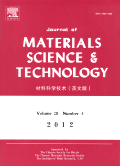
Journal of Materials Science & Technology
Pioneering Insights for Tomorrow's MaterialsThe Journal of Materials Science & Technology, published by JOURNAL MATER SCI TECHNOL in China, is a leading forum for the latest research in the multidisciplinary field of materials science. With the ISSN 1005-0302 and E-ISSN 1941-1162, this esteemed journal boasts an impressive impact factor and has established itself as a vital resource for professionals, researchers, and students alike. Covering a wide range of topics, including ceramics, composites, materials chemistry, mechanical engineering, and polymers, it has achieved a coveted Q1 ranking in multiple categories as of 2023, reflecting its position in the top tier of scholarly publications. Notably, the journal excels in its Scopus ranks, placing within the top 5% in categories such as Metals and Alloys and Mechanical Engineering. Aiming to foster knowledge and innovation in material development and application, the journal is committed to facilitating groundbreaking research and collaborations that propel the field forward. With its convergence of insights from 1993 to 2025, the Journal of Materials Science & Technology remains an indispensable resource for the advancement of materials science.

POWDER METALLURGY AND METAL CERAMICS
Exploring Breakthroughs in Metal CeramicsPOWDER METALLURGY AND METAL CERAMICS is a prestigious journal published by Springer, dedicated to advancing the field of powder metallurgy and the development of metal ceramics. With an ISSN of 1068-1302 and an E-ISSN of 1573-9066, this journal includes significant research contributions that explore innovative developments in materials science and engineering. Since its inception in 1993, it has garnered attention within multiple disciplines, consistently ranking in the Q2 and Q3 quartiles across categories such as Metals and Alloys, Ceramics and Composites, and Mechanics of Materials. The journal offers valuable insights into the synthesis, characterization, and applications of advanced materials, making it an essential platform for researchers, professionals, and students aiming to stay at the forefront of technological advancements in this dynamic field. Although not currently offering open access, the journal remains a critical resource for disseminating high-quality research that influences both academia and industry.

COLLOID JOURNAL
Advancing the frontiers of colloid and surface chemistry.COLLOID JOURNAL, published by PLEIADES PUBLISHING INC in the United States, is a pivotal platform for disseminating cutting-edge research in the fields of Colloid and Surface Chemistry, Physical and Theoretical Chemistry, and Surfaces and Interfaces. With an ISSN of 1061-933X and E-ISSN 1608-3067, this journal offers a valuable resource for researchers and professionals seeking to explore advancements in colloidal systems and surface phenomena. Although currently categorized in the lower quartiles (Q4) within its respective fields, the journal serves as an essential space for emerging ideas and methodologies, contributing to the broader understanding of material interactions at the micro and nano scales. The H-index and specific impact factor data are yet to be determined, but the journal maintains a dedication to high-quality peer-reviewed content that continues to shape the landscape of colloid science. Researchers and students alike will find the COLLOID JOURNAL an indispensable reference for keeping abreast of the latest developments, despite the absence of open access options, reflecting the journal's traditional publishing model. With converged years from 1989 to 2024, it represents a long-standing commitment to scholarly dissemination and exploration in its fields of study.
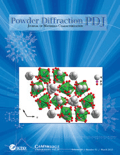
POWDER DIFFRACTION
Connecting Researchers through Pioneering Powder Diffraction StudiesPOWDER DIFFRACTION, published by Cambridge University Press, is a pivotal journal focused on the evolving field of powder diffraction, which is crucial for researchers in condensed matter physics, materials science, and radiation studies. Established in 1986, this journal emphasizes the latest methodological advancements and applications in powder diffraction techniques, making it a comprehensive resource for professionals and students alike. With an ISSN of 0885-7156 and an E-ISSN of 1945-7413, it offers valuable insights into the characterizations of crystalline materials. Although currently not open access, the journal is highly regarded for maintaining rigorous peer review standards, reflecting in its rankings within the lower quartiles of relevant fields according to Scopus. Positioned within the United States and with distribution through Cambridge University Press, POWDER DIFFRACTION aims to foster innovation and knowledge exchange among the global scientific community, thereby solidifying its role as an essential platform for disseminating research findings from 1986 through to 2024 and beyond.